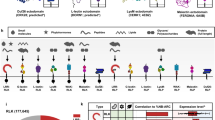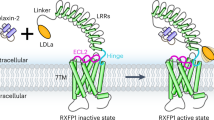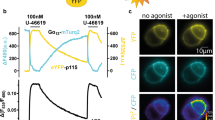Abstract
Peptide-mediated cell-to-cell signaling has crucial roles in coordination and definition of cellular functions in plants. Peptide-receptor matching is important for understanding the mechanisms underlying peptide-mediated signaling. Here we report the structure-guided identification of root meristem growth factor (RGF) receptors important for plant development. An assay based on a signature ligand recognition motif (Arg-x-Arg) conserved in a subfamily of leucine-rich repeat receptor kinases (LRR-RKs) identified the functionally uncharacterized LRR-RK At4g26540 as a receptor of RGF1 (RGFR1). We further solved the crystal structure of RGF1 in complex with the LRR domain of RGFR1 at a resolution of 2.6 Å, which reveals that the Arg-x-Gly-Gly (RxGG) motif is responsible for specific recognition of the sulfate group of RGF1 by RGFR1. Based on the RxGG motif, we identified additional four RGFRs. Participation of the five RGFRs in RGF-induced signaling is supported by biochemical and genetic data. We also offer evidence showing that SERKs function as co-receptors for RGFs. Taken together, our study identifies RGF receptors and co-receptors that can link RGF signals with their downstream components and provides a proof of principle for structure-based matching of LRR-RKs with their peptide ligands.
Similar content being viewed by others
Log in or create a free account to read this content
Gain free access to this article, as well as selected content from this journal and more on nature.com
or
References
Lease KA, Walker JC . The Arabidopsis unannotated secreted peptide database, a resource for plant peptidomics. Plant Physiol 2006; 142:831–838.
Matsubayashi Y, Sakagami Y . Peptide hormones in plants. Annu Rev Plant Biol 2006; 57:649–674.
Grienenberger E, Fletcher JC . Polypeptide signaling molecules in plant development. Curr Opin Plant Biol 2015; 23:8–14.
Shiu SH, Bleecker AB . Plant receptor-like kinase gene family: diversity, function, and signaling. Sci STKE 2001; 2001:22.
Han Z, Sun Y, Chai J . Structural insight into the activation of plant receptor kinases. Curr Opin Plant Biol 2014; 20:55–63.
Petricka JJ, Winter CM, Benfey PN . Control of Arabidopsis root development. Annu Rev Plant Biol 2012; 63:563–590.
Aichinger E, Kornet N, Friedrich T, Laux T . Plant stem cell niches. Annu Rev Plant Biol 2012; 63:615–636.
Matsuzaki Y, Ogawa-Ohnishi M, Mori A, Matsubayashi Y . Secreted peptide signals required for maintenance of root stem cell niche in Arabidopsis. Science 2010; 329, 1065–1067.
Whitford R, Fernandez A, Tejos R, et al. GOLVEN secretory peptides regulate auxin carrier turnover during plant gravitropic responses. Dev Cell 2012; 22:678–685.
Meng L, Buchanan BB, Feldman LJ, Luan S . CLE-like (CLEL) peptides control the pattern of root growth and lateral root development in Arabidopsis. Proc Natl Acad Sci USA 2012; 109:1760–1765.
Aida M, Beis D, Heidstra R, et al. The PLETHORA genes mediate patterning of the Arabidopsis root stem cell niche. Cell 2004; 119, 109–120.
Galinha C, Hofhuis H, Luijten M, et al. PLETHORA proteins as dose-dependent master regulators of Arabidopsis root development. Nature 2007; 449, 1053–1057.
Mahonen AP, Tusscher K, Siligato R, et al. PLETHORA gradient formation mechanism separates auxin responses. Nature 2014; 515:125–129.
Gilroy S . Plant tropisms. Curr Biol 2008; 18:R275–R277.
Fernandez A, Drozdzecki A, Hoogewijs K, et al. Transcriptional and functional classification of the GOLVEN/ROOT GROWTH FACTOR/CLE-like signaling peptides reveals their role in lateral root and hair formation. Plant Physiol 2013; 161:954–970.
Fernandez A, Drozdzecki A, Hoogewijs K, et al. The GLV6/RGF8/CLEL2 peptide regulates early pericycle divisions during lateral root initiation. J Exp Bot 2015; 66, 5245–5256.
Cederholm HM, Benfey PN . Distinct sensitivities to phosphate deprivation suggest that RGF peptides play disparate roles in Arabidopsis thaliana root development. New Phytol 2015; 207:683–691.
Huffaker A, Pearce G, Ryan CA . An endogenous peptide signal in Arabidopsis activates components of the innate immune response. Proc Natl Acad Sci USA 2006; 103:10098–10103.
Tang J, Han Z, Sun Y, Zhang H, Gong X, Chai J . Structural basis for recognition of an endogenous peptide by the plant receptor kinase PEPR1. Cell Res 2015; 25:110–120.
Ogawa M, Shinohara H, Sakagami Y, Matsubayashi Y . Arabidopsis CLV3 peptide directly binds CLV1 ectodomain. Science 2008; 319:294.
Stenvik GE, Tandstad NM, Guo Y, et al. The EPIP peptide of inflorescence deficient in abscission is sufficient to induce abscission in Arabidopsis through the receptor-like kinases HAESA and HAESA-LIKE2. Plant Cell 2008; 20:1805–1817.
Tabata R, Sumida K, Yoshii T, Ohyama K, Shinohara H, Matsubayashi Y . Perception of root-derived peptides by shoot LRR-RKs mediates systemic N-demand signaling. Science 2014; 346:343–346.
Yamaguchi Y, Pearce G, Ryan CA, et al. The cell surface leucine-rich repeat receptor for AtPep1, an endogenous peptide elicitor in Arabidopsis, is functional in transgenic tobacco cells. Proc Natl Acad Sci USA 2006; 103:10104–10109.
Etchells JP, Turner SR . The PXY-CLE41 receptor ligand pair defines a multifunctional pathway that controls the rate and orientation of vascular cell division. Development 2010; 137:767–774.
Hou S, Wang X, Chen D, et al. The secreted peptide PIP1 amplifies immunity through receptor-like kinase 7. PLoS Pathog 2014; 10:e 1004331.
Endo S, Shinohara H, Matsubayashi Y, Fukuda H . A novel pollen-pistil interaction conferring high-temperature tolerance during reproduction via CLE45 signaling. Curr Biol 2013; 23:1670–1676.
Du J, Yin H, Zhang S, et al. Somatic embryogenesis receptor kinases control root development mainly via brassinosteroid-independent actions in Arabidopsis thaliana. J Integr Plant Biol 2012; 54:388–399.
Zhang H, Lin X, Han Z, Qu L, Chai J . Crystal structural of PXY-TDIF complex reveals a conserved recognition mechanism among CLE peptide-receptor pairs. Cell Res 2016; 26:543–55
Wang J, Li H, Han Z, et al. Allosteric receptor activation by the plant peptide hormone phytosulfokine. Nature 2015; 525:265–268.
Shinohara H, Mori A, Yasue N, Sumida K, Matsubayashi Y . Identification of three LRR-RKs involved in perception of root meristem growth factor in Arabidopsis. Proc Natl Acad Sci USA 2016; 113:3897–3902.
Ou Y, Lu X, Zi Q, et al. RGF1 INSENSITIVE 1 to 5, a group of LRR receptor-like kinases, are essential for the perception of root meristem growth factor 1 in Arabidopsis thaliana. Cell Res. 2016 May 27. doi: 10.1038/cr.2016.63
Otwinowski Z, Minor W . Processing of X-ray diffraction data collected in oscillation mode. Methods Enzymol 1997; 276:307–326.
McCoy AJ, Grosse-Kunstleve RW, Adams PD, Winn MD, Storoni LC, Read RJ . Phaser crystallographic software. J Appl Crystallogr 2007; 40:658–674.
Emsley P, Cowtan K . Coot: Model-building tools for molecular graphics. Acta Crystallogr D Biol Crystallogr 2004; 60:2126–2132.
Adams PD . PHENIX: Building new software for automated crystallographic structure determination. Acta Crystallogr D Biol Crystallogr 2002; 58:1948–1954.
DeLano WL . PyMOL Molecular Viewe 2002 (http://www.pymol.org).
Jerabek-Willemsen M, Wienken CJ, Braun D, Baaske P, Duhr S . Molecular interaction studies using microscale thermophoresis. Assay Drug Dev Technol 2011; 9:342–353.
Clough SJ, Bent AF . Floral dip: a simplified method for Agrobacterium-mediated transformation of Arabidopsis thaliana. Plant J 1998; 16:735–743.
Sparkes IA, Runions J, Kearns A, Hawes C . Rapid transient expression of fluorescent fusion proteins in tobacco plants and generation of stably transformed plants. Nat Protoc 2006; 1:2019–2025.
Acknowledgements
We thank S Huang and J He at Shanghai Synchrotron Radiation Facility (SSRF) for assistance with data collection; H Deng and J Liu at the center for Biomedical Analysis of Tsinghua University for MS analysis; L Li and A Jiang at Peking University for providing the incubator. We acknowledge the Tsinghua University Branch of China National Center for Protein Sciences Beijing for providing the facility support. This work was funded by Projects of International Cooperation and Exchanges of the National Natural Science Foundation of China (31420103906), the Ministry of Science and Technology of China (2015CB910200) and State Key Program of the National Natural Science of China (31130063 and 31421001) to JC; the National Natural Science Foundation of China (91217305 and 91017010) to HG.
Author information
Authors and Affiliations
Corresponding authors
Additional information
( Supplementary information is linked to the online version of the paper on the Cell Research website.)
Supplementary information
Supplementary information, Figure S1
Identification of the LRR-RK At4g26540 as a receptor of RGF1 by Gel-filtration and MS. (PDF 100 kb)
Supplementary information, Figure S2
Quantitative assays of RGFR1LRR interaction with RGFs. (PDF 246 kb)
Supplementary information, Figure S3
Conserved recognition mechanism of RGFs by RGFR1. (PDF 327 kb)
Supplementary information, Figure S4
Sequence alignment the extracellular LRR domains of RGFR1-5. (PDF 702 kb)
Supplementary information, Figure S5
RGF1 interacts with RGFR2LRR in vitro. (PDF 75 kb)
Supplementary information, Figure S6
RGFR1/2 expression patterns in root. (PDF 318 kb)
Supplementary information, Figure S7
Expression patterns of RGFs and RGFRs. (PDF 272 kb)
Supplementary information, Figure S8
Schematic map of the T-DNA insertion mutants of rgfr1, rgfr2, rgfr3, rgfr4 and rgfr5. (PDF 147 kb)
Supplementary information, Figure S9
Dose-dependent RGF1 response pattern of Col-0. (PDF 92 kb)
Supplementary information, Figure S10
RGF1 induced meristem response in rgfr mutants. (PDF 110 kb)
Supplementary information, Figure S11
RGF1 binding induces no oligomerization of RGFR1LRR in vitro. (PDF 103 kb)
Supplementary information, Figure S12
RGF1 induces RGFR1LRR-SERKs heterodimerization. (PDF 152 kb)
Supplementary information, Figure S13
RGF1-5, 8 but not RGF6, 7, 9 induce RGFR1LRR-SERK1LRR heterodimerization in vitro. (PDF 260 kb)
Supplementary information, Figure S14
The RxR motif are conserved in different plant species. (PDF 461 kb)
Supplementary information, Table S1
Peptide list. (PDF 359 kb)
Supplementary information, Table S2
Summary of crystallography analysis. (PDF 389 kb)
Supplementary information, Table S3
Primer list. (PDF 116 kb)
Rights and permissions
About this article
Cite this article
Song, W., Liu, L., Wang, J. et al. Signature motif-guided identification of receptors for peptide hormones essential for root meristem growth. Cell Res 26, 674–685 (2016). https://doi.org/10.1038/cr.2016.62
Received:
Revised:
Accepted:
Published:
Issue date:
DOI: https://doi.org/10.1038/cr.2016.62
Keywords
This article is cited by
-
HSL1 and BAM1/2 impact epidermal cell development by sensing distinct signaling peptides
Nature Communications (2022)
-
CLE peptides: critical regulators for stem cell maintenance in plants
Planta (2022)
-
Nodule Rich Protein 2 modulates nodule number in Medicago truncatula
Plant Biotechnology Reports (2021)
-
GOLVEN peptide signalling through RGI receptors and MPK6 restricts asymmetric cell division during lateral root initiation
Nature Plants (2020)
-
RGF1 controls root meristem size through ROS signalling
Nature (2020)



